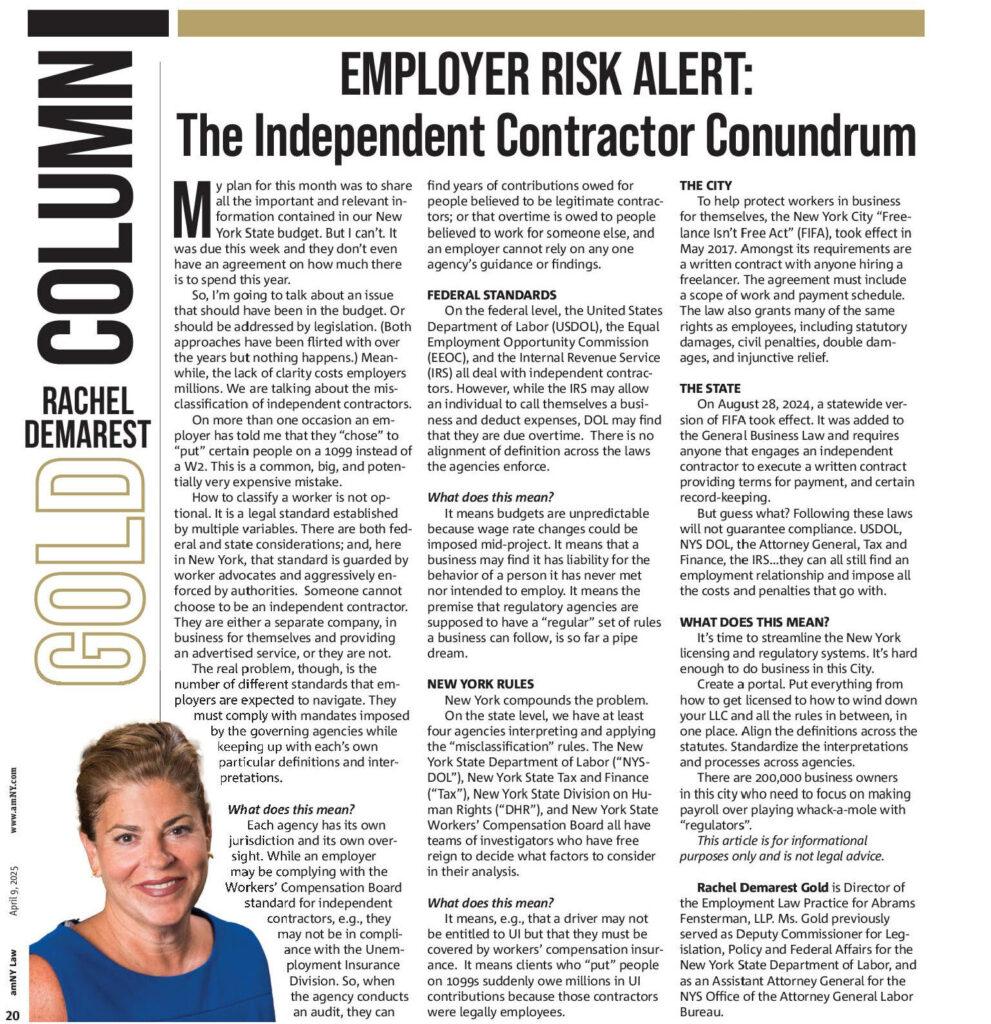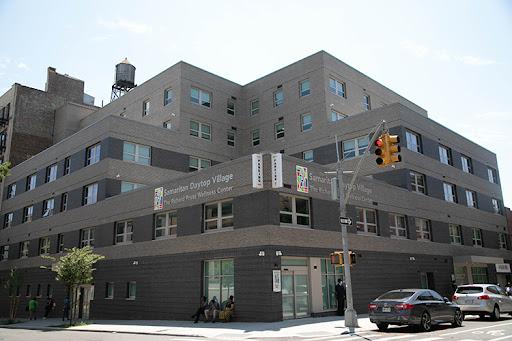Law360
New York City’s strict limitations on the growth of Uber, Lyft and other app-based ride-hailing services are aimed at increasing drivers’ earning potential and cutting traffic congestion, but the mixed-bag approach to leveling the competition between tech-based companies and traditional taxicabs may blow back on consumers, experts say.
Mayor Bill de Blasio and the New York City Council unveiled a batch of legislative initiatives and rule changes Wednesday with a two-fold mission: tighten the reins on for-hire vehicles and app-based ride-hailing services by curbing their numbers and practices while simultaneously giving legacy taxicabs a break by eliminating renewal fees for city-issued taxi licenses, known as medallions.
The efforts underscore the delicate dance that city officials have had to perform since the entry of Uber Technologies Inc., Lyft Inc. and other ride-hailing services flooded the Big Apple with more cars competing for riders, hammering traditional taxicabs that for years benefited from city protections that ensured taxi medallions were a safe economic bet.
“There are policy-based arguments on both sides,” said Dan Handman, a Los Angeles-based partner at Hirschfeld Kraemer LLP. “Consumer protection advocates will say the taxicab industry is a monopoly, and if you can charge whatever price you want, it works as a detriment. But if you’re arguing that the cabdrivers bought these medallions at an inflated price because they knew they would get the benefit of that system, it wasn’t their fault they lost all that value.”
The city’s plan to extend and eventually make permanent what was originally intended to be a one-year freeze on new for-hire vehicle licenses is a positive first step, but some attorneys say there’s more the city can do to reset the industry without leaving consumers holding the bag.
Passengers will likely shoulder the brunt of the policy changes with fewer available vehicles or longer wait times for rides and higher fares overall.
“The permanent cap on for-hire vehicle licenses alone does not adequately address the consequences of nearly a decade of government inaction,” said Arthur Goldstein, chair of Davidoff Hutcher & Citron LLP’s New York City government relations practice group, who has previously represented taxi drivers and medallion owners in other matters.
“There are still effectively two taxi markets: heavily regulated yellow and green cabs and nearly unregulated cars using ride-hailing apps,” said Arthur Goldstein. “New York City has undermined the value of taxi medallions by handcuffing those who invested based on the government’s presumed public interest in maintaining a solid regulatory scheme and thus a relatively stable value.”
Goldstein said that the city needs to reduce the number of ride-hail cars on the road, “just as we have a limit on the number of yellow cabs,” to accomplish the city’s goal of allowing all drivers to earn a fair wage.
Since the city’s medallion system was created in 1937, the New York City Taxi & Limousine Commission has always tightly controlled the number of medallions, which give taxicabs the exclusive right to pick up hails directly from the street. Currently, there are approximately 14,000 New York City medallions in the market. But since the city first began regulating ride-hailing services, which it calls “transportation network companies,” in late 2012, the number of drivers with for-hire vehicle licenses has ballooned to 80,000.
“We are still wrestling with what the effects are of that kind of flooding of the market, and it’s a clear fact that drivers all across the board are making less money,” said Ethan Gerber, director of the transportation practice at Abrams Fensterman Fensterman Eisman Formato Ferrara Wolf & Carone LLP, who has represented yellow taxicabs and limo companies. “With limited ridership, you can’t just keep pumping cars and expect any of the drivers to earn a living.”
The new rules are meant to complement the first-of-its-kind minimum pay rate that New York City recently established to bolster the earning potential for ride-hailing app drivers. The New York City Taxi & Limousine Commission in December approved new rules establishing a per-minute and per-mile minimum trip payment formula that works out to a minimum pay rate of $17.22 per hour for drivers who drive for app-based for-hire vehicle services such as Uber, Lyft, Juno and Via. Those rules took effect in February.
Uber has ripped New York City’s latest measures, saying the extended cap “will create another medallion system — the same kind that bankrupted drivers and enriched lenders.”
In addition to indefinitely extending the one-year cap, the city will introduce new limits on how long for-hire vehicles can “cruise” Manhattan’s core, below 96th Street, without any passengers while they’re waiting to accept requests from would-be riders. That’s another hit to how ride-hail drivers operate: Cruising around with empty vehicles usually shortens the wait time for customers requesting rides through the apps, but it also clogs the streets with traffic.
City officials said their data indicates that for-hire vehicles spend 41% of their time just “cruising” through Manhattan without passengers. The new cap would restrict cruising time to 36% by next February. By August 2020, that cap will drop to 31%.
It remains to be seen how the city’s experiments will impact consumers in the long run, especially because they are already paying a congestion surcharge under a state tax law that took effect in February. Taxicabs have been charging New York City riders an extra $2.50, while for-hire vehicles, including black cars as well as Uber, Lyft and the like, have charged riders an additional $2.75 for rides that begin, end or enter Manhattan below 96th Street.
That’s separate from a congestion pricing plan that state lawmakers approved in the state budget this spring seeking to impose tolls on all vehicles traveling into Manhattan at 60th Street or below. Revenue from the to-be-determined tolls will flow to the Metropolitan Transportation Authority, which runs New York’s public transit system.
“The congestion pricing hurt drivers and owners. It’s just basic economics. In addition, the management companies now have to pay credit card processing fees [on surcharges] that are going straight to the MTA and no one is compensating them for that. It’s not equivalent to a restaurant raising its rates. It’s just a net loss for them.”
— Ethan Gerber
At the same time, the city took steps Wednesday to prop up a medallion industry filled with debt-ridden drivers who paid inflated prices for medallions that were supposed to give them a lock on potentially lucrative street hails citywide for years to come. The city auctioned off limited amounts of medallions to the point where they hit a peak price of $1.3 million apiece in 2014, but it now has to grapple with a crisis it helped create, experts say.
“The TLC really did encourage speculation in this market,” said Gerber. “They put out what looked like prospectuses showing the historic increase of medallions and encouraged medallion purchases. After having sold them [at such high prices], they do owe an obligation to those investors who bought these medallions.”
To that end, the city is cutting taxicabs a break by waiving the $1,100 fee they have to pay every two years to renew their medallions, establishing additional oversight and providing additional resources to help medallion owners manage their debt.
The City Council also introduced a bill that would create an Office of Financial Stability within the New York City Taxi & Limousine Commission to evaluate the taxicab industry’s finances in collaboration with the city Department of Investigations. Another bill would require the TLC to review and approve sales and transfers of any medallion and evaluate the “character and integrity” of medallion brokers, and another bill would require any would-be medallion owner to submit annual financial disclosures.
The city and lenders in the medallion industry are already facing the heat since New York Attorney General Letitia James announced last month that her office would launch an inquiry into reports of allegedly predatory lending practices surrounding New York City’s once-coveted taxicab medallions.
And with the new rules, some attorneys say additional legal challenges may be coming, given that Uber already sued city officials in February in state court to block the initial one-year moratorium that was announced in August. The court is currently considering the city’s motion to dismiss that suit.
There could be a flip in the script on which party argues that the city’s differing rules for ride-hailing companies and taxicabs tramples on drivers’ constitutional rights. The taxicab industry for years has waged largely unsuccessful legal battles across the country claiming cities and municipalities deprived them of property or their rights to earn an income by enacting uneven and often laissez-faire rules for ride-hailing services.
But it could now be ride-hailing services and for-hire drivers that might try to press that argument if they drag New York City to court over the new rules.
“Unless they get some type of ruling in the near future, the cap is around to stay,” said Handman. “The cruising issue is different though. To impose limits on someone’s ability to travel creates constitutional issues, but the government has the ability to do that because you don’t have the absolute right to travel anywhere you want anytime you want.”
But courts have sided with cities and municipalities, granting them deference on their choice of rules related to taxicabs and transportation network companies as long as regulators make the case that there’s a legitimate government interest for the rules.
“Ultimately, I suspect that a court — if they were to hear a challenge on the cruising issue — would apply a rational basis test,” said Handman.”If the rule is rationally related to a legitimate government interest, then that’s all well and good so long as they have a rational reason for furthering that purpose. Courts have uniformly said that if that’s how the city chooses to enforce its laws, then that’s how they’re going to do it … because it serves purposes that they think are in the public interest.”
—Editing by Jill Coffey.





